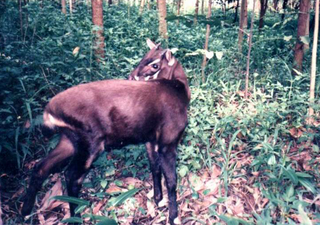Related Research Articles

Võ Nguyên Giáp was a Vietnamese general, communist revolutionary and politician. Regarded as one of the greatest military strategists of the 20th century, Giáp led Vietnamese communist forces to victories in wars against Japan, France, South Vietnam and the United States, and China. Giáp was the military commander of the Việt Minh and the People's Army from 1941 to 1972, minister of defense of the Democratic Republic of Vietnam and the Socialist Republic of Vietnam in 1946–1947 and from 1948 to 1980, and deputy prime minister from 1955 to 1991. He was a member of the Politburo of the Communist Party of Vietnam.

Vietnam, officially the Socialist Republic of Vietnam, is a country at the eastern edge of mainland Southeast Asia, with an area of about 331,000 square kilometres (128,000 sq mi) and a population of over 100 million, making it the world's fifteenth-most populous country. One of the two Marxist–Leninist states in Southeast Asia, Vietnam shares land borders with China to the north, and Laos and Cambodia to the west. It shares maritime borders with Thailand through the Gulf of Thailand, and the Philippines, Indonesia, and Malaysia through the South China Sea. Its capital is Hanoi and its largest city is Ho Chi Minh City.

The green peafowl or Indonesian peafowl is a peafowl species native to the tropical forests of Southeast Asia and Indochina. It is the national bird of Myanmar. Formerly common throughout Southeast Asia, only a few isolated populations survive in Cambodia and adjacent areas of Vietnam. It has been listed as endangered on the IUCN Red List since 2009, primarily due to widespread deforestation, agriculture and loss of suitable habitat, severely fragmenting populations and contributing to an overall decline in numbers. The green peafowl is in demand for private and home aviculture and threatened by the pet trade, feather collectors and hunters for meat and targeted.

Pamela Cecile Rasmussen is an American ornithologist and expert on Asian birds. She was formerly a research associate at the Smithsonian Institution in Washington, D.C., and is based at the Michigan State University. She is associated with other major centers of research in the United States and the United Kingdom.

Edwards's pheasant is a bird of the pheasant family Phasianidae and is endemic to the seasonal tropical forests of central Vietnam. It is named after the French ornithologist Alphonse Milne-Edwards and first described to science in 1896. The bird's length is 58–65 centimetres (23–26 in) and has red legs and facial skin. The male is mainly blue-black with a crest, and the female is a drab brown bird. The alarm call is a puk!-puk!-puk!.

The Vietnamese pheasant, or Vietnam fireback, was formerly considered a species of gallopheasant, Lophura hatinhensis, but is now considered a variant of Edward's pheasant. Discovered in 1964, it is endemic to central Vietnam. Its range concentrates around Kẻ Gỗ Nature Reserve in Hà Tĩnh Province.

Phong Nha-Kẻ Bàng is a national park and UNESCO World Heritage Site in the Bố Trạch and Minh Hóa districts of central Quảng Bình Province in the North Central Coast region of Vietnam, about 500 km south of Hanoi. The park borders the Hin Namno National Park in Khammouane Province, Laos to the west and 42 km east of the East sea from its borderline point. Phong Nha-Kẻ Bàng National Park is in a limestone zone of 2,000 km2 in Vietnamese territory and borders another limestone zone of 2,000 km2 of Hin Namno in Laotian territory. The core zone of this national park covers 857.54 km2 and a buffer zone of 1,954 km2.

The silver pheasant is a species of pheasant found in forests, mainly in mountains, of mainland Southeast Asia and eastern and southern China. It is introduced on Victoria Island in Nahuel Huapi Lake, Neuquén, Argentina and on Vancouver Island, Canada. The male is black and white, while the female is mainly brown. Both sexes have a bare red face and red legs. It is common in aviculture, and overall also remains common in the wild, but some of its subspecies are rare and threatened.

Jean Théodore Delacour was a French ornithologist and aviculturist. He later became American. He was renowned for not only discovering but also rearing some of the rarest birds in the world. He established very successful aviaries twice in his life, stocked with birds from around the world, including those that he obtained on expeditions to Southeast Asia, Africa and South America. His first aviary in Villers-Bretonneux was destroyed in World War One. The second one that he established at Clères was destroyed in World War Two. He moved to the United States of America where he worked on avian systematics and was one of the founders of the International Committee for Bird Protection. One of the birds he discovered was the imperial pheasant, later identified as a hybrid between the Vietnamese pheasant and the silver pheasant.

Salvadori's pheasant is a landfowl bird of genus Lophura, native to Indonesia. It is found in the mountain rainforests of Sumatra. Thus it is also known as the Sumatran pheasant. The Hoogerwerf's pheasant is usually thought to be a subspecies. This bird was first described in 1879 by the Italian ornithologist Tommaso Salvadori. The species name inornata means "without ornament".

The kalij pheasant, or simply kalij, is a pheasant found in forests and thickets, especially in the Himalayan foothills, from Nepal, Pakistan to western Thailand. Males are rather variable depending on the subspecies involved, but all have at least partially glossy bluish-black plumage, while females are overall brownish. Both sexes have a bare red face and greyish legs. It is generally common and widespread, though three of its eastern subspecies are considered threatened and L. l. moffitti is virtually unknown in the wild. On 21 October 2021, the Government of Jammu and Kashmir declared Kalij Pheasant as bird of the Union Territory of Jammu and Kashmir.

Bulwer's pheasant, also known as Bulwer's wattled pheasant, the wattled pheasant or the white-tailed wattled pheasant, is a Southeast Asian bird in the family Phasianidae endemic to the forests of Borneo. It is currently listed as Vulnerable by the IUCN.
The imperial pheasant is a gallopheasant from Southeast Asia. Long thought to be an enigmatic and elusive species, it is actually a cross of Edwards's pheasant and the silver pheasant, a hybrid.

The Siamese fireback, also known as Diard's fireback, is a fairly large, approximately 80 cm (31 in) long, pheasant. The male has a grey plumage with an extensive facial caruncle, crimson legs and feet, ornamental black crest feathers, reddish brown iris and long curved blackish tail. The female is a brown bird with blackish wings and tail feathers.

The wildlife of Vietnam is rich in flora and fauna as reflected by its unique biodiversity. Saola, rare and antelope-like animal categorized under the bovine subfamily, was found in 1992 in Vũ Quang National Park. In the 1990s, three other muntjac species, the deer-like Truong Son muntjac, giant muntjac and Pu Hoat muntjac, were also discovered. Conservation protection and scientific studies of the ecology of Vietnam, particularly in the protected forest areas, have been given priority attention by the Government of Vietnam. Laws were enacted to set up Xuân Thủy Wetland National Park, four UNESCO Biosphere Reserves, and Hạ Long Bay and Phong Nha-Kẻ Bàng National Parks; the last two are also designated as UNESCO World Heritage Sites.

Swinhoe's pheasant, also known as the Taiwan blue pheasant, is a bird of the pheasant subfamily in the fowl family Phasianidae. It is endemic to Taiwan. Along with the Mikado pheasant and Taiwan blue magpie, two other Taiwan endemics, Swinhoe's pheasant is sometimes considered an unofficial national symbol for Taiwan, as it bears the colours of the national flag.
Kẻ Gỗ Nature Reserve is a nature reserve in Vietnam. It is located in three districts of this province, namely: Cẩm Xuyên, Thạch Hà, Hương Khê. It was established by the Decision No. 519/QD-UB dated May 3, 1997 of the Ha Tinh People's Committee. The purpose of this establishment is to protect the endangered Vietnamese pheasant and the imperial pheasant as well as biodiversity in the southern area of this province. In this area, there exists nearly 100 species of amphibians and reptiles as shown by the German biologist Dr. Thomas Ziegler. Large mammals are rare, due to the high hunting pressure. So there is probably no more elephants. Ke Go is home to one of the last lowland rainforests of Vietnam. The management board includes about 70 persons, inclusive of 56 rangers. Illegal loggings, poaching and exploitation of oil threaten this habitat. The Netherlands and ORO-VERDE financially supported a project for the conservation of the reserve.

Vietnam: The Last Battle is a 1995 Carlton Television documentary, written and presented by John Pilger, and directed by David Munro, which returns to Vietnam nearly twenty years after the Vietnam War had ended to review those two decades.

Many areas of Vietnam are under protection. While the national reserves cover small areas of scientific significance with restricted access, the national parks also cover wetlands of Ramsar designated areas and BirdLife International inscribed bird areas. The largest of the national parks initially covered were the Cúc Phương National Park, the Cát Tiên National Park, and the Côn Đảo National Park which to start with were forest areas cum reserves or prohibited areas. The objective for creating national parks was to allow access to the reserved areas as a part of ecotourism and cultural needs with full attention to the basic approach of conservation of natural environmental resources.
Events in the year 2017 in Vietnam.
References
- ↑ Ives, Mike (11 January 2017). "Vo Quy, Father of Environmental Conservation in Vietnam, Dies at 87". The New York Times.